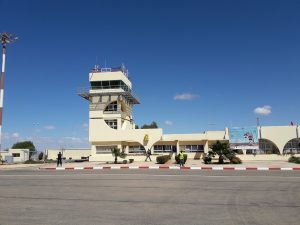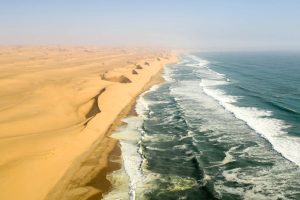The region has a road network extending over 4,753 kilometers, of which more than 50% is asphalted. This network benefits from regular renovations through redevelopment and construction operations.
The Guelmim-Oued Noun region, a land of civilizations and a crossroads of cultures, is distinguished by its unique natural and economic assets. With ambitious human-centered development projects, it is moving forward with hope towards a bright and sustainable future.
Important geostrategic location
The Guelmim-Oued Noun region is the gateway to the Moroccan Sahara and a meeting point between the north and south of the kingdom, giving it an essential strategic role in promoting economic and cultural exchanges within the region.
Varied infrastructure
The Guelmim-Oued Noun region, as the gateway to the Moroccan Sahara and a meeting point between the north and south of the kingdom, has diverse infrastructure that plays an important strategic role in strengthening economic and cultural exchanges within the region.
.
Guelmim Airport is located northwest of the city, covering an area of 755 hectares. It is able to accommodate various types of flights, thus facilitating the movement of the region’s inhabitants to the northern cities, thus alleviating their difficulties. In collaboration with the highway, these air links play a significant role in increasing the attractiveness of the region and strengthening its economic activity.

Tan-Tan Airport is located 6 kilometers southwest of the city, covering more than 570 hectares. It is able to accommodate various types of flights and has regular air traffic with five weekly flights from Casablanca and Guelmim.

The port of Tan-Tan is an important hub for regional and national development, as it accommodates coastal, traditional and deep-sea fishing boats. Covering 78.5 hectares, it has two industrial zones housing several units dedicated to processing, cooling and manufacturing.

The port of Sidi Ifni is an important industrial center dedicated to fishing, located 70 km north of the city. It is the main source of local income and strengthens socio-economic activity at both the regional and national levels. In addition, it has fully equipped land in the industrial zone, offering real investment opportunities.


The Guelmim-Oued Noun region is distinguished by a coastal line extending over 282.8 kilometers.
Province Sidi Ifni
Province Guelmim
Province Tan-Tan
The region has five industrial zones:
– Industrial zone at the port: 70 hectares (Port of Laâyoune – Port of Tan-Tan)
– Additional industrial zone at the port: 44 hectares (Laâyoune – Port of Tan-Tan)
– Industrial zone of the city of Tan-Tan: 32 hectares (Center of Tan-Tan)
– Industrial zone “A”: 48 hectares (Port of Sidi Ifni)
– Industrial zone near the port: 35 hectares (Port of Sidi Ifni)

La région de Guelmim-Oued Noun, terre des civilisations et carrefour des cultures, se distingue par ses atouts naturels et économiques uniques. Avec des projets de développement ambitieux axés sur l’humain, elle avance avec espoir vers un avenir radieux et durable.
Situation géostratégique importante
La région de Guelmim-Oued Noun est la porte du Sahara marocain et un point de rencontre entre le nord et le sud du royaume, lui conférant un rôle stratégique essentiel dans la promotion des échanges économiques et culturels au sein de la région.
Infrastructures variées
La région de Guelmim-Oued Noun, en tant que porte du Sahara marocain et point de rencontre entre le nord et le sud du royaume, dispose d’infrastructures diverses qui jouent un rôle stratégique important dans le renforcement des échanges économiques et culturels au sein de la région.
La région dispose d’un réseau routier s’étendant sur 4 753 kilomètres, dont plus de 50 % sont asphaltés. Ce réseau bénéficie de rénovations régulières à travers des opérations de réaménagement et de construction.

L’aéroport de Guelmim est situé au nord-ouest de la ville, sur une superficie de 755 hectares. Il est en mesure d’accueillir divers types de vols, facilitant ainsi le déplacement des habitants de la région vers les villes du nord, allégeant ainsi leurs difficultés. En collaboration avec l’autoroute, ces liaisons aériennes jouent un rôle significatif dans l’augmentation de l’attractivité de la région et le renforcement de son activité économique.

L’aéroport de Tan-Tan est situé à 6 kilomètres au sud-ouest de la ville, s’étendant sur plus de 570 hectares. Il est capable d’accueillir différents types de vols et connaît un trafic aérien régulier avec cinq vols hebdomadaires en provenance de Casablanca et de Guelmim.

Le port de Tan-Tan constitue un pôle important pour le développement régional et national, car il accueille des bateaux de pêche côtière, traditionnelle et en haute mer. S’étendant sur 78,5 hectares, il dispose de deux zones industrielles abritant plusieurs unités dédiées à la transformation, au refroidissement et à la fabrication.

Le port de Sidi Ifni est un centre industriel important dédié à la pêche, situé à 70 km au nord de la ville. Il constitue la principale source de revenus locaux et renforce l’activité socio-économique à la fois au niveau régional et national. De plus, il dispose de terrains entièrement équipés dans la zone industrielle, offrant de réelles opportunités d’investissement.


La région de Guelmim-Oued Noun se distingue par une ligne côtière s’étendant sur 282,8 kilomètres.
Province Sidi Ifni
Province Guelmim
Province Tan-Tan
La région compte cinq zones industrielles :
– Zone industrielle au port : 70 hectares (Port de Laâyoune – Port de Tan-Tan)
– Zone industrielle supplémentaire au port : 44 hectares (Laâyoune – Port de Tan-Tan)
– Zone industrielle de la ville de Tan-Tan : 32 hectares (Centre de Tan-Tan)
– Zone industrielle “A” : 48 hectares (Port de Sidi Ifni)
– Zone industrielle près du port : 35 hectares (Port de Sidi Ifni)

World center and ideal climate for renewable energy production
Thanks to its sunny climate all year round and its open position on the coast with northwesterly winds, the Guelmim-Oued Noun region constitutes a unique setting for renewable energy production plants of all kinds, including solar panels and wind turbines, thus generating electricity and green hydrogen.
Abundant fisheries resources
The Guelmim-Oued Noun region benefits from significant and varied fisheries resources, with a high commercial value. The maritime fishing sector plays a key role in the economic development of the region. It is home to two major ports, the port of Tan-Tan and the port of Sidi Ifni, which are among the most important fishing centers at the national level.
Promising agricultural assets
The Guelmim-Oued Noun region has solid agricultural assets that make it a promising area in the sector. Thanks to its rich resources and great potential, as well as a favorable climate, it allows the cultivation of high value-added products. The arable area exceeds 191,000 hectares, with a diversity of crops, including olive trees, almond trees, citrus fruits, date palms and sugar beets. In addition, the region is distinguished by a significant animal sector, producing red meat, dairy products, poultry and honey.
Promising potential in aquaculture
The Guelmim-Oued Noun region is an ideal starting point for aquaculture thanks to its strategic position. It offers abundant marine resources, including shellfish and fish, creating great opportunities for the development of this sector. In addition, the region has dedicated areas extending over 850 hectares for the establishment of marine organism breeding projects, thus contributing to an estimated production of 43,000 tons.
Diversity of environments and abundant natural resources
The Guelmim-Oued Noun region is distinguished by a unique environmental diversity, combining the Anti-Atlas ranges, vast plains, golden sand beaches and green oases. This enchanting natural landscape attracts visitors and offers them a rich and varied tourist experience.
Rich history and diverse cultural heritage
The Guelmim-Oued Noun region is an area with an ancient historical heritage and a deep-rooted civilization, whose roots date back to prehistoric times. Its cultural wealth has flourished in various fields over the centuries. The region occupies an important place, having been the scene of dynamic exchanges between cultures and civilizations throughout the ages. The historical remains bear witness to this great past and express a rich and diverse heritage that tells the story of the region through time.